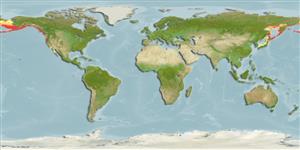Classification / Names
Common names from other countries
Main reference
Size / Weight / Age
Max length : 100.0 cm FL male/unsexed; (Ref. 559); common length : 58.0 cm TL male/unsexed; (Ref. 3561); max. published weight: 15.9 kg (Ref. 40637); max. reported age: 7 years (Ref. 1998)
Length at first maturity
Lm 70.0 range ? - ? cm
Environment
Marine; freshwater; brackish; benthopelagic; anadromous (Ref. 51243); depth range 0 - 250 m (Ref. 50550), usually ? - 61 m (Ref. 96339)
Climate / Range
Temperate; ? - 24°C (Ref. 35682), preferred 4°C (Ref. 107945); 67°N - 24°N, 130°E - 110°W (Ref. 54684)
Distribution
Short description
Dorsal
spines
(total): 0;
Dorsal
soft rays
(total): 10-14;
Anal
spines: 0;
Anal
soft rays: 13 - 17;
Vertebrae: 59 - 71. Distinguished by the lack of distinct black spots on the back and tail and by the presence of 18 to 28 short, stout, smooth gill rakers on the first arch (Ref. 27547). Pelvic fins with axillary process; caudal truncate to slightly emarginate (Ref. 27547). Large individuals are steel-blue dorsally, with speckles of black; silver on the sides; silvery to white ventrally. Males have tinges of black on the tips of its caudal, anal and pectoral fins. Spawning males are dark olive to black dorsally; grey-red with green vertical bars on the sides; dark grey ventrally; anal and pelvic fins with white tips. Spawning females resemble spawning males but less distinctly marked.
IUCN Red List Status (Ref. 115185)
Threat to humans
Harmless
Human uses
Fisheries: highly commercial; aquaculture: commercial; gamefish: yes; aquarium: public aquariums
Tools
Special reports
Download XML
Internet sources
Estimates of some properties based on models
Phylogenetic diversity index
PD50 = 0.5000 many relatives (e.g. carps) 0.5 - 2.0 few relatives (e.g. lungfishes)
Trophic Level
3.7 ±0.2 se; Based on diet studies.
Resilience
Medium, minimum population doubling time 1.4 - 4.4 years (K=0.27-0.45; tm=2-5; tmax=6)
Vulnerability
Moderate to high vulnerability (49 of 100)
Price category
